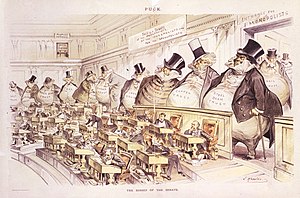Homo sapiens
From Wikipedia, the free encyclopedia
| Homo sapiens Temporal range: Pleistocene - Recent | |
|---|---|
| Conservation status | |
| Scientific classification | |
| Kingdom: | Animalia |
| Phylum: | Chordata |
| Class: | Mammalia |
| Order: | Primates |
| Family: | Hominidae |
| Tribe: | Hominini |
| Genus: | Homo |
| Species: | H. sapiens |
| Binomial name | |
| Homo sapiens Linnaeus, 1758 | |
| Subspecies | |
| †Homo sapiens idaltu Homo sapiens sapiens †Homo neanderthalensis? †Homo rhodesiensis? | |
Homo sapiens (Latin: "wise man") is the binomial nomenclature (also known as the scientific name) for the human species. Homo is the human genus, which also includes Neanderthals and many other extinct species of hominid; H. sapiens is the only surviving species of the genus Homo. Modern humans are the subspecies Homo sapiens sapiens, which differentiates them from what has been argued to be their direct ancestor, Homo sapiens idaltu.
Subspecies
Subspecies of H. sapiens include Homo sapiens idaltu and the only extant subspecies Homo sapiens sapiens. Some sources show Homo sapiens neanderthalensis as a subspecies of H. sapiens. Similarly, the discovered specimens of the Homo rhodesiensis species have been classified by some as a subspecies, but this classification is not widely accepted.Evolution

Skulls of
1. Gorilla 2. Australopithecus 3. Homo erectus 4. Neanderthal (La Chapelle aux Saints) 5. Steinheim Skull 6. Homo sapiens
1. Gorilla 2. Australopithecus 3. Homo erectus 4. Neanderthal (La Chapelle aux Saints) 5. Steinheim Skull 6. Homo sapiens
Scientific study of human evolution is concerned, primarily, with the development of the genus Homo, but usually involves studying other hominids and hominines as well, such as Australopithecus. "Modern humans" are defined as the Homo sapiens species, of which the only extant subspecies is known as Homo sapiens sapiens.
Homo sapiens idaltu (roughly translated as "elder wise human"), the other known subspecies, is now extinct.[1] Homo neanderthalensis, which became extinct 30,000 years ago, has sometimes been classified as a subspecies, "Homo sapiens neanderthalensis"; genetic studies now suggest that the functional DNA of modern humans and Neanderthals diverged 500,000 years ago.[2]
Similarly, the discovered specimens of the Homo rhodesiensis species have been classified by some as a subspecies, but this classification is not widely accepted.
Anatomically modern humans first appear in the fossil record in Africa about 195,000 years ago, and studies of molecular biology give evidence that the approximate time of divergence from the common ancestor of all modern human populations was 200,000 years ago.[3][4][5][6][7] The broad study of African genetic diversity found the ǂKhomani San people to express the greatest genetic diversity among the 113 distinct populations sampled, making them one of 14 "ancestral population clusters". The research also located the origin of modern human migration in south-western Africa, near the coastal border of Namibia and Angola.[8][9]
Evolutionary history of Primates
The evolutionary history of primates can be traced back 65 million years (mya).[10] Primates are one of the oldest of all surviving placental mammal groups. The oldest known primate-like mammal species (those of the genus Plesiadapis) come from North America, but inhabited Eurasia and Africa on a wide scale during the tropical conditions of the Paleocene and Eocene.Within family Hominidae, orangutans (Ponginae) were the first to diverge, followed by gorillas. Molecular evidence suggests that the last common ancestor between humans and chimpanzees (Pan) diverged 4–8 million years ago, making humans and chimps the closest relations among the great apes.[11] Current estimates of suggested concurrence between functional human and chimpanzee DNA sequences range between 95% and 99%.[12][13][14][15] The functional portion of human DNA is approximately 98.4% identical to that of chimpanzees when comparing single nucleotide polymorphisms (see human evolutionary genetics).[11]
Early estimates indicated that the human lineage may have diverged from that of chimpanzees about five million years ago, and from that of gorillas about eight million years ago. However, a hominid skull discovered in Chad in 2001, classified as Sahelanthropus tchadensis, is approximately seven million years old, and may be evidence of an earlier divergence.[16]
Human evolution is characterized by a number of important changes—morphological, developmental, physiological, and behavioural—which have taken place since the split between the last common ancestor of humans and chimpanzees. The first major morphological change was the evolution of a bipedal locomotor adaptation from an arboreal or semi-arboreal one,[17] with all its attendant adaptations (a valgus knee, low intermembral index (long legs relative to the arms), reduced upper-body strength).
The human species developed a much larger brain than that of other primates – typically 1,400 cm³ in modern humans, over twice the size of that of a chimpanzee or gorilla. The pattern of human postnatal brain growth differs from that of other apes (heterochrony), and allows for extended periods of social learning and language acquisition in juvenile humans. Physical anthropologists[who?] argue that the differences between the structure of human brains and those of other apes are even more significant than their differences in size.
Other significant morphological changes included the evolution of a power and precision grip,[18] a reduced masticatory system, a reduction of the canine tooth, and the descent of the larynx and hyoid bone, making speech possible. An important physiological change in humans was the evolution of hidden oestrus, or concealed ovulation, which may have coincided with the evolution of important behavioural changes, such as pair bonding. Another significant behavioural change was the development of material culture, with human-made objects becoming increasingly common and diversified over time. The relationship between all these changes is the subject of ongoing debate.[19][20]
The forces of natural selection have continued to operate on human populations, with evidence that certain regions of the genome display directional selection in the past 15,000 years.[21]

